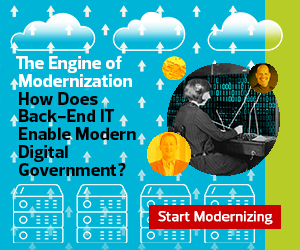For state governments, pandemic pressures pushed technology adoption into high gear. Virtually overnight, digital transformation shifted from future plan to fundamental feature, effectively driving IT operations out of the data center and across networks at large. From executive suites to marketing departments, in human resources offices and for frontline staff, technology became the glue that held government agencies together — even when employees were nowhere near each other.
A key challenge is that staff with minimal IT knowledge and experience suddenly found themselves as de facto technology department leaders in their own homes. Along with troubleshooting common network issues and ensuring reliable connections, frontline employees had to simultaneously reduce complexity and increase performance — all under the umbrella of secure government systems.
In some cases, this meant downloading and installing approved applications to help boost overall productivity. In others, staff ran up against the problem of missing features and functions that would make their jobs easier.
Low-code and no-code platforms offer a way to solve this problem by turning staff into citizen developers with the power to build basic apps that solve specific issues and streamline operations.
But what exactly is a citizen developer? What are low-code/no-code platforms? How do they work — and how can they benefit government agencies?
RELATED: Explore the technology and approaches needed to quickly enable digital government.
What Is Low-Code/No-Code Development?
“Low-code and no-code development platforms are tools for people who don’t know how to code,” says Frank Downs, director of proactive services at BlueVoyant and a member of ISACA’s emerging trends working group. “They’re like big blocks and a flowchart — you can put blocks A, B and C together to get block D.”
He uses the example of a staff member looking to build a better reporting application. He or she could easily combine a report generator block, a formatter block and a printer block, and the resulting application simply works.
While these low-code and no-code frameworks are underpinned by actual coding languages — such as PHP, Python or Java — end users don’t need to worry about the details. Instead, they’re presented with visual software development environments that allow them to drag and drop application components, connect them together, and see what happens. In effect, staff can design, test and even deploy apps using a familiar flowchart-style model that’s entirely focused on ease of use.
Downs likens differing platforms to different types of Legos. Basic no-code and low-code solutions are similar to the larger Duplo blocks used by younger children: They make building as easy as possible, but the total number of functional permutations is limited. More in-depth platforms offer the mix-and-match capabilities of the smaller-sized Lego sets, in turn allowing skilled citizen developers to dig deeper.
While these tools come with the benefit of speed and simplicity, Downs says there are potential challenges. For example, not all no-code and low-code platforms are created equal — with a host of free and paid options available, government agencies must ensure that staff only have access to approved and vetted tools that meet current compliance requirements.
“Some organizations like MIT are building these tools and they’re free,” he says. “Other companies are trying to turn a profit. Some require payment up front, some are subscription, some you have to pay X amount per user.”
While it’s theoretically possible for experienced development teams to unpack the underlying code of useful created applications, it’s often easier to start from scratch in preferred coding frameworks, which requires both time and resources.
EXPLORE: How can the cloud help accelerate digital services adoption?
What Are Citizen Developers?
Research firm Gartner offers a straightforward definition: “A citizen developer is an employee who creates application capabilities for consumption by themselves or others, using tools that are not actively forbidden by IT or business units.”
Downs offers a more succinct interpretation of a citizen developer: “It’s someone who got fed up and said, ‘Fine, I’ll do it myself.’”
For Downs, this approach to citizen development stems from the fact that when staff are in the field, they have to deal with tools and technologies that don’t work right out of the box. “Some things won’t line up,” he says. “They have to work on the back end to make it more functional, or the front end to make reports look better.”
In practice, however, the impetus to improve applications isn’t always commensurate with IT knowledge. “Employees want to improve applications but may not have any coding experience,” Downs says. “When I started at ISACA, I developed a grading system to grade individual staff capabilities. While I have some coding background, it wasn’t my main focus. I used no-code/low-code frameworks to build a proof of concept.”
It should be noted that with or without any IT training, citizen developers are effectively business technologists. However, as Gartner notes, not all technologists are necessarily developers. In practice, the only requirement for this modular moniker is that individuals are active employees of their organization.
How Can Low-Code/No-Code Development Be Used to Benefit Agencies?
While the low-code/no-code approach isn’t perfect — and is often the result of citizen developers fed up with the pace of application creation — it does offer several benefits for government agencies, such as:
- Creating proofs of concept. No-code and low-code tools offer a way for citizen developers to show government executives their ideas for improved applications can work in practice. Instead of simply presenting theory, staff can offer working proof and help drive executive buy-in and convince leadership to assign more robust development resources to the project.
- Increasing task efficiency. As Downs notes, the reduced amount of development time required for no-code and low-code apps makes them ideal for increasing everyday task efficiency. If staffers can build their own versions of familiar apps or quickly deploy much-needed functions, they can address their own operational concerns without getting IT involved.
- Avoiding the “good idea paradox.” Downs has seen it more than once: Staff members have a good idea for a new feature or application but only come with the idea itself. Unless the idea is good enough to get full development support, it never makes it past the brainstorming stage. Low-code and no-code solutions let citizen developers convert good ideas into simple apps, in turn offering a practical starting point that helps avoid the “good idea paradox.”
- Empowering remote work. With many staff members still working from home — and hybrid work approaches here to stay — it’s impossible for in-house IT teams to manage the sheer variety and volume of staff network connections, application preferences and much-needed features. Equipped with no-code and low-code tools, however, employees can build what they need when they need it.=
FREE RESOURCES: Get the tools you need to modernize your IT infrastructure.
Government-Compliant Low-Code/No-Code Platforms
According to Downs, the adoption of low-code and no-code platforms “is still relatively nascent at the government level. Not all agencies allow these tools because they don’t want to create a security issue.”
Still, these solutions are making inroads — as noted by Forbes, the U.S. State Department leveraged ServiceNow’s low-code App Engine to create, develop and deliver nearly a dozen apps to diplomats worldwide during the early days of the pandemic.
Some of the most widely used and government-approved platforms include:
- App Engine by ServiceNow. AppEngine by ServiceNow has seen use at both state and federal levels: In addition to being used to create COVID-19 apps for the State Department, the platform was also used to establish a centralized dispatch framework for emergency teams responding to U.S. wildfires. In practice, AppEngine makes it possible for government agencies to create new applications in half the time and at one-third the cost of traditional development methods.
- Honeycode by AWS. Honeycode by AWS uses familiar spreadsheet functions such as sheets, tables and formulas to help users quickly create new apps, and also offers templates for commonly created apps such as task trackers and event management tools. This government-approved low-code platform has already been used by private enterprise partners to provide government agencies with key document deliverables that require a high degree of compliance.
- PowerApps by Microsoft. PowerApps by Microsoft is available in both per-app and per-user frameworks, and according to the official PowerApps site is “available to US federal, state, local, tribal and territorial government entities and other entities that handle data that is subject to government regulations and requirements.” Last year, the platform was used by the Washington State Department of Health to create and deploy its Regional Government Emergency Response and Monitoring solution. The tool provides an aggregated view of COVID-19 cases and resources and is now used in 115 hospitals across the state.
Citizen developers are driving the next phase of digital transformation for state operations. Downs puts it simply: “Used properly, no-code and low-code frameworks can be a force multiplier for government agencies.”











